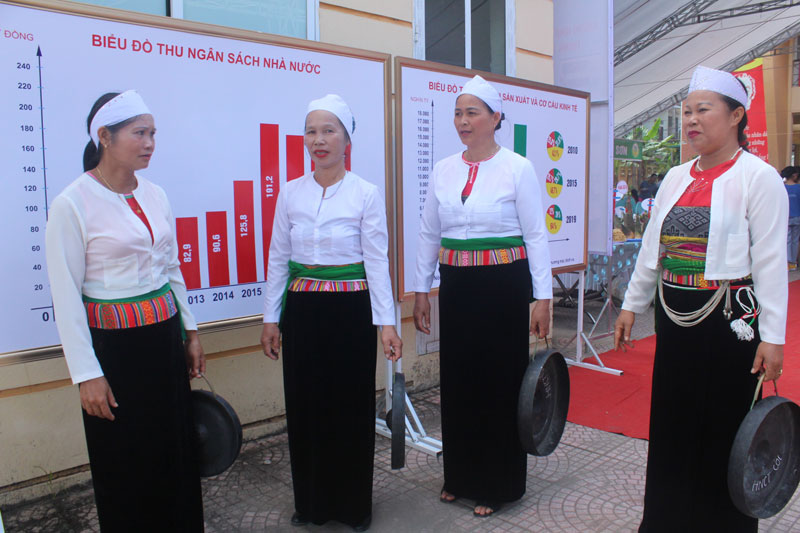
(HBO) - Hoa Binh province has ethnic groups living with the whole province population of 85.4 thousand people. In which, ethnic minorities account for 74.31% of the population, including Muong, Thai, Tay, Dao, Mong and some other ethnic minorities.
1. Muong ethnic people
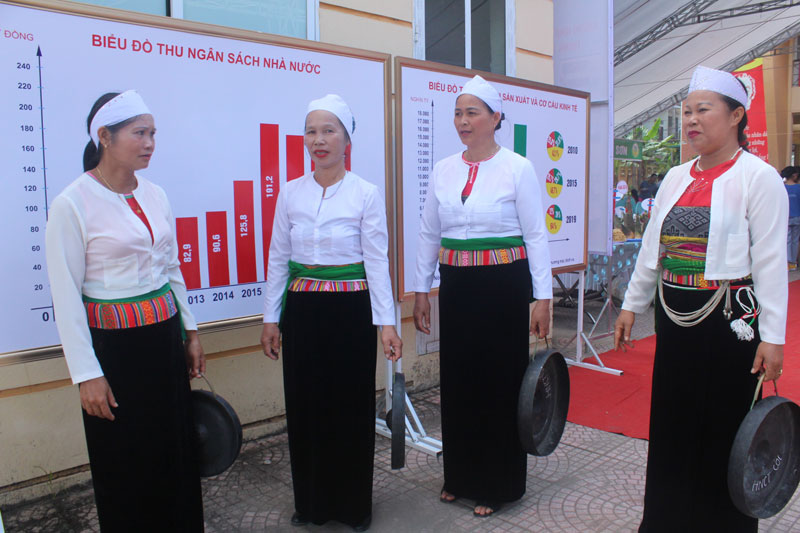
- Self-created name: Mooi
- The language group: Viet - Muong
- The characteristics of the costume: Muong women's outfit is more diverse than that of the men and still retains its elegance and discreetness. It includes a white headscarf, a blouse with the round neck and the shorter body compared to the sleeves, a long black skirt with the sophisticatedly embroidered cuff and the overall. The jewelry is usually bracelets, bead chains and a set of silver 2-4-wire vestiges with a snail box containing betel nut, and silver-encrusted claws of animals.
- The characteristics of the daily life and production activities: Muong ethnic people live in houses on stilts, in low-lying valleys and hills along rivers and streams, concentrating in Muong and villages with a few dozen houses. They have a long tradition of water rice cultivation, agricultural and forestry production. In addition, there are handicrafts such as cotton growing, cloth weaving and knitting.
Ruou Can (wine drunk out of a jar through pipes) of Muong ethnic people is famous for its processing and rich taste. The people still retain many unique cultural features such as: Con Festival in Spring, Gong Festival, some customs, rituals of wedding and funeral. and there are a lot of effective herbal remedies handed down from generations to generations.
- The Muong ethnic group accounts for 63.79% of the whole provincial population, residing in the districts and the city in the province, but most concentrating in Kim Boi, Lac Son, Tan Lac, Luong Son, Yen Thuy Cao Phong ang Ky Son districts.
2 – Thai ethnic people
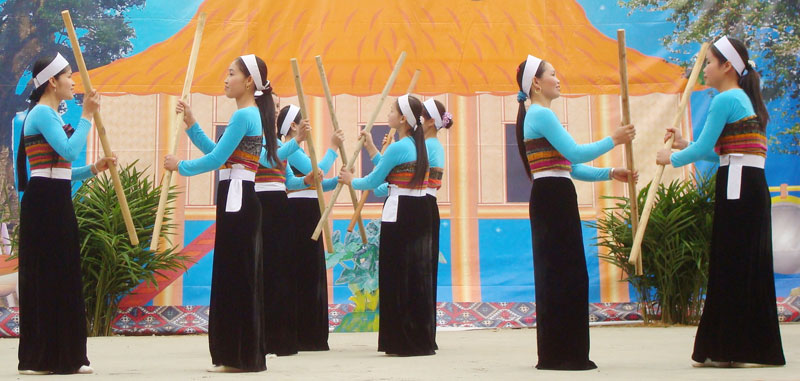
- The self-created name: Tay or Thay
- The language group: Tay – Thai. The Thai script has the letters of the Sanscrit, following the oral learning tradition.
- Costumes: Thai women wear short-bodied blouses with silver buttons in the shape of butterflies, spiders or cicadas… The blouses with round neck small hems, ripped shoulders appropriate with a dark tubular skirt. The waist is tied with a white back band with a short tassel on the left hip. A folded white scarf is often put on the head. Men wear pants cut to the waist and the breasted blouses with pockets on each side of the hem. Today, Thai costumes have many changes to suit the production and living conditions.
- The daily life and production activity: Thai people have a tradition of cultivating water rice and improving terraced fields, mainly engaged in agriculture, forestry, cotton growing, silkworm raising and weaving and producing fine arts and crafts.
The food is processed quite picky. It is indispensable for the some raw vegetables such as basil, mill, coriandrum sativum and so on the tray. The main spices in dishes are spicy, sour, bitter ...
- Thai ethnic group accounts for 4.06% of the whole provincial population, residing concentratedly in Mai Chau district.
3 – Tay ethnic people
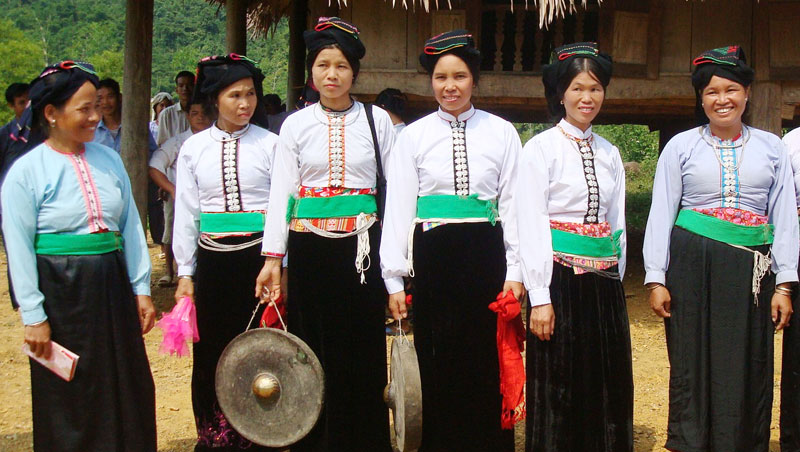
- Other names: Tho
- The language group: Tay - Thai. Tay script is built on hieroglyphic characters, which is currently being eroded, and few people are able to write.
- The costumes: The Tay's costume is made of self-woven cotton fabric, which is dyed indigo and embroidered and decorated only a little. Women wear skirts or pants, short blouses inside and long dresses outside. There are indigo-dyed scarfs tied on the head.
- Living and production activities: Tay ethnic people live in stilt houses, concentrating in a village of a few dozen houses. The production mainly focuses on agriculture and forestry. In addition, there is some handicraft such as weaving and rattan and bamboo knitting.
Food is often made from sticky rice and is often used during festivals. They mainly cook food with dried items or grilled and well-cooked. Tay people, in November or December there is a custom of making new rice to thank the ancestors, the gods giving good health and good harvests following the lunar calendar.
- Tay ethnic group accounts for 2.89% of the provincial population, residing in Da Bac district and some communes of Mai Chau district.
4 - Dao ethnic group
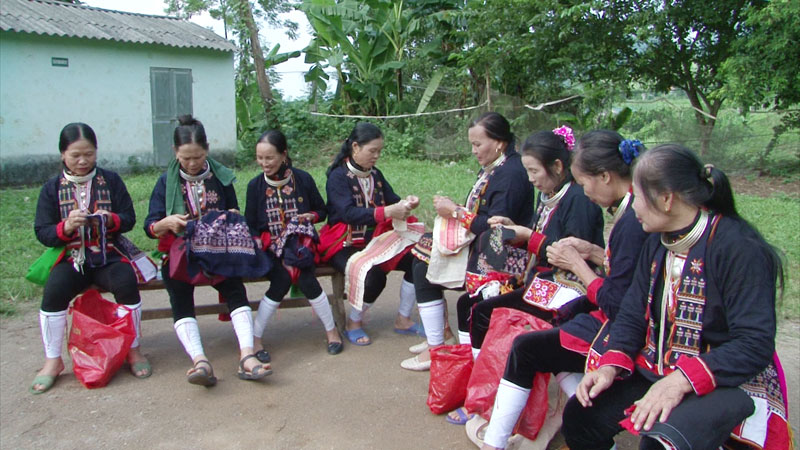
- Self- created names: Kem Mien, Kem Mun; The other name: Man..
- Thuộc nhóm ngữ hệ Mông - Dao.
- Belonging to the Mong - Dao linguistic group.
There are two branches in Hoa Binh: Dao Tam Dao (Dao Quan Chet) and Dao Tien. The two branches have a number of different characteristics about their clothes, customs and activities. At the same time, there is little relationship about marriage and they do not live in the same village.
- Costumes: Dao Quan Chet women wear long-sleeved dresses. When wearing dresses, they wring the lap over their waist. The lap is decorated with blue, red, purple and white squares. The scarf is tied on the head. The pants are embroidered with the shapes of flowers with the tight bears, short wearing on the calves and their legs are wrapped in white leggings. The men wear a shirt with the shape of a seal on the neck and the upper and the lower part of the pocket are embroidered with different patterns.
Dao Tien women wear knee-high skirts, carved with wax patterns, wearing a black scarf with the silver-decorated turban on the head. The legs are wrapped in leggings with printed flowers.
Living and production activities: Dao ethnic people have been living in Hoa Binh for a long time with a habit of living in high mountains, building wooden low houses, usually at the head of water sources. They have a habit of shifting cultivation and hunting. Dao people are very good at some occupations such as: growing cotton, weaving, indigo dyeing, printing with beeswax. The have been maintaining the manual smith chart to create production and hunting tools and make jewelry; Especially, there is a profession in producing Ban paper from Do tree for making writing paper and ghost money...
Dao's customs also maintain a self-sufficient production and the characteristics of funerals and weddings. Cap Sac festival is one of the unique festivals of Dao people. Every year, Dao people have many days of taboos and festival. They use the lunar calendar and the script with a hieroglyphic character from the Chinese language.
-Dao ethnic group accounts for 1.91% of the province's population, residing in small villages in some districts: Kim Boi, Da Bac, Cao Phong, Ky Son, Mai Chau, Luong Son and Hoa Binh City.
5 – Mong ethnic people
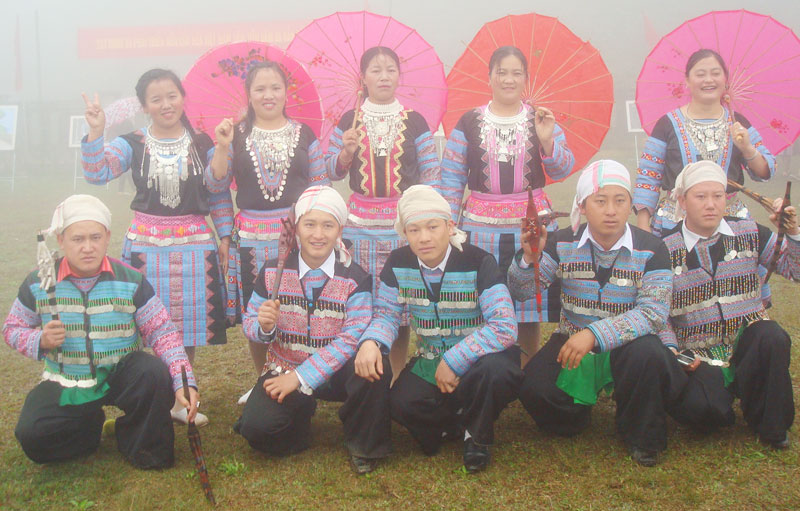
- The self-created name: H’Mong; Other name: Cats
- Belonging to the Mong - Dao linguistic group.
- Costumes: Mong women wear long-sleeved black blouses. The front lap is short to the waist, the back lap is slightly longer. The sleeves are added with green or red cloth. The skirt is indigo-dyed with floral patterns and added with colorful thread. The decorations on the clothes are mainly made up of colored cloth mosaics and the embroidery patterns are mainly in the shapes of squares, fillings and cross. They usually wear a lot of silver bracelets arranged at the neck, the blue and red beaded waistband and many silver coins and silver bells tied together in a line. Men's clothing is often black, extending the sleeves with cloth added red and blue thread. They wear a wide tube with a blue waistband tied in the front and it is dropped down.
- The characteristics of the daily life and production activities: H'mong people live in a ground-floor houses, concentrating in a village of a few dozen houses, often on high mountains. They have experiences in shifting cultivation, growing cotton and weaving and manufacturing production tools, handicrafts, and making things for living is also very popular.
Mong people have a tradition of processing food and drinks from corn, some cakes from corn, rice, and cassava. They often make separate food storage to prevent rats and fire.
Although the written language has been prepared in the Vietnamese national syllabus, it is not yet widely used.
Every year H'mong people celebrate Tet festival one month earlier than Lunar New Year. The customs still remain relatively pristine. In particular, in the festivals and New Year, the man often exchanges his feelings through the music of the trumpet and special Quay games.
- Mong ethnic group accounts for 0.65% of the provincial population, residing in two communes of Pa Co, Hang Kia in Mai Chau district.
With an increasingly vibrant and widespread emulation movement aimed at building cultured residential areas and cultured families, Yen Thuy District has been making steady progress toward improving both the material and spiritual well-being of its people, while fostering a civilized, prosperous, beautiful, and progressive community.
Once lacking recreational spaces and community facilities, Residential Group 2 in Quynh Lam Ward (Hoa Binh City) has recently received attention for the construction of a new, spacious, and fully equipped cultural house. The project followed the model of state support combined with public contributions in both labor and funding.
The "All people unite to build cultural life" movement, which has been effectively integrated with Kim Boi district’s socio-economic development goals, is fostering a lively spirit of emulation across local residential areas, hamlets, villages, public agencies, and enterprises. In addition, through the initiative, traditional cultural values are being preserved and promoted, while community solidarity and mutual support in poverty reduction and economic development are being strengthened.
A working delegation of the Hoa Binh provincial People’s Committee led by its Permanent Vice Chairman Nguyen Van Toan on June 11 inspected the progress of a project to build the Mo Muong Cultural Heritage Conservation Space linked to tourism services in Hop Phong commune, Cao Phong district.
Born and growing in the heroic land of Muong Dong, Dinh Thi Kieu Dung, a resident in Bo town of Kim Boi district, in her childhood was nurtured by the sweet lullabies of her grandmother and mother. These melodies deeply imprinted on her soul, becoming an inseparable part of her love for her ethnic group's culture. For over 20 years, this love for her hometown has driven Dung to research, collect, and pass down the cultural values of the Muong people to future generations.
In the final days of May, the Ethnic Art Troupe of Hoa Binh Province organized performances to serve the people in remote, mountainous, and particularly disadvantaged areas within the province. These were not just ordinary artistic shows, but they were the meaningful journeys aimed at spreading cultural values, enhancing the spiritual life of the people and contributing to the preservation of ethnic minority cultural identities.







